June 1, 2015 - During and after World War II there were many war movies made like “Twelve O’clock High” and “30 Seconds Over Tokyo”. In my mind many of the stories I’ve written about local veterans the past couple of years could  be put on the big screen. None more so than Center, Texas’ own A. B. Hughes, Jr. Looking at his photo Clark Gable would be a dead ringer to play the part.
be put on the big screen. None more so than Center, Texas’ own A. B. Hughes, Jr. Looking at his photo Clark Gable would be a dead ringer to play the part.
It all began with his birth in Center, Texas on August 10th, 1915 to parents Aquilla Ballard Hughes, Sr. (1884 – 1951) and Sarah Jane (Sally) Davis Hughes (1876 – 1942). His father was listed as a farmer in the 1930 census and they lived in Precinct 1. His parents were well known throughout the county for their singing and helped out with many revivals.
 Aquilla Ballard Hughes, Jr.
Aquilla Ballard Hughes, Jr.
Lieutenant Colonel, United States Army Air Forces, World War II
341st Bombardment Squadron, Eighth Air Force
Silver Star Recipient
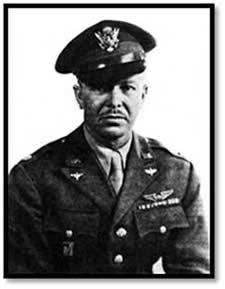
Aquilla, Jr. known as “Hughie” to his family and friends graduated from Center High School with the class of 1933 and enrolled at the University of Texas where he completed three years. In 1936 he received an appointment to the United States Military Academy at West Point, New York. During his “plebe year” (first) the family received a letter from the Congressman Martin Dies that was published in the Champion Newspaper of January 28th, 1937. It read “Dear Friends, We had a very nice visit with your fine son on inauguration day. He telephoned me the moment he arrived in the city and we had him to dinner and my boy took him to a show that night. We were favorably impressed with him and feel very proud of him. He is an unusually fine looking boy and I predict for him a brilliant future. He is doing well at West Point and while he is home sick to a certain extent, he seems to be well satisfied with the school. My wife and I introduced him to several members of Congress and to our Senators and everyone complimented him highly. With kindest regards and best wishes I am sincerely yours, Martin Dies”.
Cadet Hughes received his first furlough from the Academy in June, 1937 and another in August, 1938. Each time returning to Center to visit with his parents and family. He was a member of the Black Knights football team and in 1938 and was awarded an Academy Monogram per special orders issued by the Superintendent, Brigadier General Jay L. Benedict. The monogram was awarded to those members of the squad who did not earn the “A” letter but played in 1/10th of the total playing time in the season and in one-half of the games. Army went 8 and 2 that year and more importantly beat Navy 14-7. The next year, 1939 Hughes advanced to the grade of Cadet Sergeant by order of the Academy Superintendent. He also sang in the Cadet Chapel Choir. The following was printed under his photo above in the Howitzer Yearbook of 1940. “I’m plumb tuckered out” and with these words Hughie would hit his red comforter. That is, every night except Saturday when he would emerge from his shell to shine at the hops. Studies were just an interlude compared to the brighter week-ends when he could put aside his books and “drag.” A golden-haired son of Texas, he never lost his patient, kind, understanding, and idealistic individuality. “Hughie”.
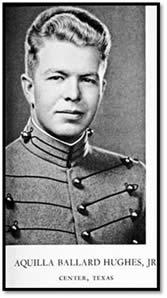 He spent Christmas, 1939 in Center with family and friends and on June 11th, 1940 he graduated from West Point as a Second Lieutenant and immediately entered active duty with the US Army Air Forces. After a short visit home Lt. Hughes was sent to Love Field, Texas to begin his flying training orientation. He then attended primary and advanced flying schools at Kelly Field, Texas with Class 41-B and earned his silver pilot wings on March 14th, 1941. He also was promoted to First Lieutenant the same year.
He spent Christmas, 1939 in Center with family and friends and on June 11th, 1940 he graduated from West Point as a Second Lieutenant and immediately entered active duty with the US Army Air Forces. After a short visit home Lt. Hughes was sent to Love Field, Texas to begin his flying training orientation. He then attended primary and advanced flying schools at Kelly Field, Texas with Class 41-B and earned his silver pilot wings on March 14th, 1941. He also was promoted to First Lieutenant the same year.
The March 20th, 1941 edition of the “Champion Newspaper” reported the marriage of Miss Constance Dalziel and Lieutenant Aquilla Ballard Hughes, Jr. took place at 2:00 p.m. Friday at Randolph Field Chapel with the Rev. Claude Canterbury officiating. She was born in Jackson, Michigan and grew up in Chicago, Illinois. March 20th was on a Thursday and the previous Friday was March 14th, the same day he graduate from pilot training. They honeymooned in Corpus Christi, Texas.
Later than year on December 23rd, 1941 his parents celebrated their Golden Wedding Anniversary in their home in the Sardis Community. The “Champion Newspaper” of January 1st, 1942 reported that they had twelve children, one of whom died in infancy. Ten others were with their parents on this occasion but the war situation kept Lieutenant A. B. Hughes, Jr. away. An open house was not held due to his mother’s failing health. Lieutenant Hughes was able to visit them a couple of months later when his B-17 bomber on a routine training flight from Gowen Field, Boise, Idaho stopped over at Barksdale Field, Louisiana.
While stationed at Gowen Field, Idaho he was promoted to the grade of Captain in April, 1942. In June of 1942, Captain Hughes was sent first to Iceland and then to England where he flew as a B-17 Heavy Bomber Pilot in the European Theater, flying 45 bombing raids out of England and North Africa. On most of these raids his was the lead aircraft with the other B-17’s in the formation dropping their bombs on the signal from the lead bombardier. Captain John Fisher Taylor of Center was Captain Hughes’ bombardier on a few of these missions until he was promoted to group bombardier. During this time on July 10th, 1942 his mother, the former Sallie Davis passed away. The obituary did not say if Captain Hughes was at the funeral but in all probability with WW II in full swing he was not.
 On September 7th, 1942 Captain Hughes and his crew were part of a fifteen B-17 formation destined to bomb the Nazi Wilton Shipyards in Rotterdam, Netherlands. A weather storm warning was sent to the crews and most returned home early. Seven aircraft however failed to receive the warning and continued on toward the target. They were jumped by fifteen German F-W 109 fighters. Despite the efforts of the defending RAF fighters that downed three of the German planes, the B-17F flown by Captain Aquilla Hughes was singled out by the German pilots and after a number of attacking passes he was forced to drop out of the formation and try for home. With his ball turret belly gunner killed and three others wounded they fought off the German fighter planes, shot down at least four of them, dropped to a lower altitude and somehow made it back to England on just two engines. Once back over his home field the drama was not over as Captain Hughes found that his brakes were not working and in order to stop the aircraft before the runway was used up he elected to steer the plane to the grass and dirt areas off the runway.
On September 7th, 1942 Captain Hughes and his crew were part of a fifteen B-17 formation destined to bomb the Nazi Wilton Shipyards in Rotterdam, Netherlands. A weather storm warning was sent to the crews and most returned home early. Seven aircraft however failed to receive the warning and continued on toward the target. They were jumped by fifteen German F-W 109 fighters. Despite the efforts of the defending RAF fighters that downed three of the German planes, the B-17F flown by Captain Aquilla Hughes was singled out by the German pilots and after a number of attacking passes he was forced to drop out of the formation and try for home. With his ball turret belly gunner killed and three others wounded they fought off the German fighter planes, shot down at least four of them, dropped to a lower altitude and somehow made it back to England on just two engines. Once back over his home field the drama was not over as Captain Hughes found that his brakes were not working and in order to stop the aircraft before the runway was used up he elected to steer the plane to the grass and dirt areas off the runway.
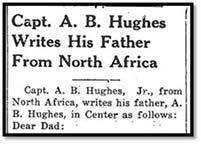 This worked and as the crew left the aircraft they found later that it had taken over 2,000 shrapnel and bullet holes but continued to fly. Every propeller blade had at least one or more bullet holes in it and there was one unexploded cannon shell intact that had entered the fuel tank near Hughes’ pilot position. Captain Hughes simple said “It was a miracle”. General Carl Spaatz (later to become the first USAF Chief of Staff) said “with more crews and aircraft like these there can be no doubt about the mastery of the air over Europe”. For his actions this day he and his crew would be awarded the Air Medal. His crew that day consisted of Lt. B. J. Stone of Pontiac, Michigan, co-pilot; Lt. M. E. Mansell of Houston, Texas, navigator; Lt. K. K. Beahan of Houston, Texas, bombardier; Sgt. Gilbert C. Goar of Clarksville, Texas, waist gunner; Sgt. Vincent Tommey of New Philadelphia, Ohio, waist gunner; Sgt. B. W. Kemble of Carbondale, Pennsylvania, top turret gunner; Sgt. Jerry Johnson of Milwaukee, Wisconsin, tail gunner; Sgt. Julius Kleiman of Bronx, New York, ball turret gunner (killed); and Sgt. Jack Falantic of Bangor, Maine, radio operator.
This worked and as the crew left the aircraft they found later that it had taken over 2,000 shrapnel and bullet holes but continued to fly. Every propeller blade had at least one or more bullet holes in it and there was one unexploded cannon shell intact that had entered the fuel tank near Hughes’ pilot position. Captain Hughes simple said “It was a miracle”. General Carl Spaatz (later to become the first USAF Chief of Staff) said “with more crews and aircraft like these there can be no doubt about the mastery of the air over Europe”. For his actions this day he and his crew would be awarded the Air Medal. His crew that day consisted of Lt. B. J. Stone of Pontiac, Michigan, co-pilot; Lt. M. E. Mansell of Houston, Texas, navigator; Lt. K. K. Beahan of Houston, Texas, bombardier; Sgt. Gilbert C. Goar of Clarksville, Texas, waist gunner; Sgt. Vincent Tommey of New Philadelphia, Ohio, waist gunner; Sgt. B. W. Kemble of Carbondale, Pennsylvania, top turret gunner; Sgt. Jerry Johnson of Milwaukee, Wisconsin, tail gunner; Sgt. Julius Kleiman of Bronx, New York, ball turret gunner (killed); and Sgt. Jack Falantic of Bangor, Maine, radio operator.
Captain Hughes was then sent to North Africa where he led bombing missions over Corsica, Sardinia, Sicily, Italy and North Africa. During this time he was also promoted to the rank of Major. A 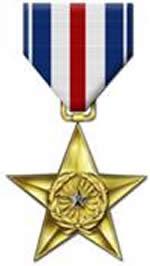 letter he wrote to his Father at Christmas, 1942 appeared in the January 7th, 1943 edition of the Champion “Dear Dad, two more bombing days till Christmas. This is a desolate place to spend Christmas. Nobody hates it any more than I do. We are doing some pretty good work now and are really working hard. As long as we are working I can stand to stay here and I have hopes of having the Germans on the run from Africa soon. If so, I think I might be able to get home sometime next year, perhaps before summer. If not, I have no idea. This is certainly a crazy country. Not at all what I expected. It gets awfully cold at times and is cold practically all the time. When the sun shines it is fairly warm, but as this is the rainy season, it’s cloudy most of the time. The people are something you never even read about in books. If you strain your imagination back to the old Biblical days you might get some idea. Camels, little donkeys the size of dogs and everything that goes with them. They live in mud huts and sleep on the ground, with all the dirt and filth you can imagine. When you get this, I hope you will have had as Merry Christmas as possible. Here’s hoping to see you before long. Lots of Love, A. B., Jr.
letter he wrote to his Father at Christmas, 1942 appeared in the January 7th, 1943 edition of the Champion “Dear Dad, two more bombing days till Christmas. This is a desolate place to spend Christmas. Nobody hates it any more than I do. We are doing some pretty good work now and are really working hard. As long as we are working I can stand to stay here and I have hopes of having the Germans on the run from Africa soon. If so, I think I might be able to get home sometime next year, perhaps before summer. If not, I have no idea. This is certainly a crazy country. Not at all what I expected. It gets awfully cold at times and is cold practically all the time. When the sun shines it is fairly warm, but as this is the rainy season, it’s cloudy most of the time. The people are something you never even read about in books. If you strain your imagination back to the old Biblical days you might get some idea. Camels, little donkeys the size of dogs and everything that goes with them. They live in mud huts and sleep on the ground, with all the dirt and filth you can imagine. When you get this, I hope you will have had as Merry Christmas as possible. Here’s hoping to see you before long. Lots of Love, A. B., Jr.
His wife Connie after receiving a letter from her husband that made her realize just how serious the war was decided to find something that she could do to help and it was reported that she enrolled in a course that would lead to a job as a riveter in an aircraft factory. After asking her son Michael about it he told me “I asked my siblings about the riveter story, and neither Chris nor Steve had ever heard anything about it. My sister Sandy also remembered nothing, but some years ago, she interviewed my mother and wrote some things down for my mom's life story. Sandy send me the following, brief, comment”. “I just looked at some old notes I made doing some of Mother’s life story and here is what I wrote…Mother worked at a munitions factory. Her job was to interview the workers and send the stories home to their hometown newspapers."
Major Hughes made his last flight on July 4th, 1943 and was then transferred from the Combat Group to the North African Air Force Headquarters. He was awarded the Nation’s fourth highest ranking medal for valor, the Silver Star for a successful raid over Tripoli when his group of twelve B-17’s were attacked by 35 German fighters and not a single American plane was lost. In addition to the Air Medal for bringing his battered plane home he earned eight more for missions in England and North Africa. He was awarded the Legion of Merit (worn sixth in the order of precedence) for exceptionally meritorious conduct with the US Army Air Forces from 1944 – 1947.
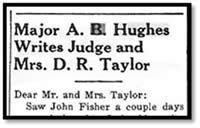 Major Hughes was good friends with John Fisher Taylor and his parents County Judge and Mrs. D. R. Taylor. In August 1943 he wrote them a heartwarming and reassuring letter that said in part “Saw John Taylor a couple of days ago and thought I would write something about the wonderful work he has done over here. He is really a ball of fire and in addition to the fact that he is probably the best bombardier in the area he is one of the most efficient officers I have ever known. Since taking the job as group bombardier, the accuracy of the group has increased tremendously. I know this war is quite a strain on both of you having so many sons mixed up in it but since they are all of superior intelligence and ability I trust they will make it thru in flying colors as John Fisher is doing. Sincerely with love almost as a son, A. B. Hughes, Jr.”.
Major Hughes was good friends with John Fisher Taylor and his parents County Judge and Mrs. D. R. Taylor. In August 1943 he wrote them a heartwarming and reassuring letter that said in part “Saw John Taylor a couple of days ago and thought I would write something about the wonderful work he has done over here. He is really a ball of fire and in addition to the fact that he is probably the best bombardier in the area he is one of the most efficient officers I have ever known. Since taking the job as group bombardier, the accuracy of the group has increased tremendously. I know this war is quite a strain on both of you having so many sons mixed up in it but since they are all of superior intelligence and ability I trust they will make it thru in flying colors as John Fisher is doing. Sincerely with love almost as a son, A. B. Hughes, Jr.”.
The war in Europe ended on May 8th, 1945 and with the dropping of the second atomic bomb on Nagasaki, Victory over Japan was official on September 2nd, 1945. It is interesting to note that the bombardier on this second mission was Kermit K. Breahan, who was Major Hughes’ bombardier on the flight that resulted in over 2,000 holes by German fighters.
Now wearing the silver oak leafs of a Lieutenant Colonel, A. B. Hughes, Jr. was assigned as Chief of the United States Air Commission to Cuba. His family was allowed to accompany him on this assignment in the fall of 1945 where he was deeply involved in Latin American planning. His father A. B., Sr. passed away on March 12, 1951 at the age of 77 and is buried in the Fairview Cemetery with his wife Sallie.
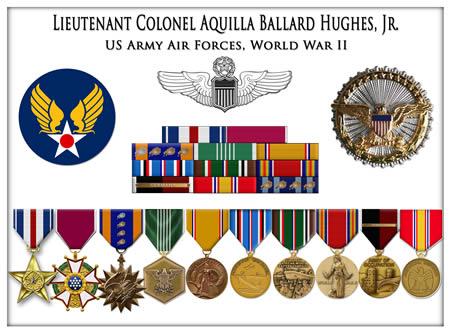
His son Michael who is a Professor of Sociology at Virginia Tech wrote me “My father was at the Pentagon during the Korean War. He worked in Research and Development. I do not know exactly what he did, but I have put together an account. In the late 1940s, the Defense Department supported his Masters of Business Administration study and degree at Stanford University. We lived in Palo Alto for two years, I think from approximately June 1947 to June 1949 (but I could check that for accuracy). We then lived in Seattle, WA, for one year, while my dad worked at Boeing Aircraft Co. I assume he was trained in business administration so that he could evaluate or study the program at Boeing from a business standpoint (for the Air Force, who was buying a lot of Boeing product). We then moved to Falls Church, VA, while my dad worked at the Pentagon (where my memory is that he worked in Research and Development) for four years. I remember at least once seeing "Top Secret" documents in the material he brought home from work. He worked on the B-52, and the B-47 (I assume on the business side -- he was not an aircraft engineer) because he talked about those aircraft, I remember. He also had models of both of them, I think given to him by Boeing, and he kept the B-52 model on his desk for the rest of his life. I do not know what happened to the B-47 model. He also talked about the Flying Wing a good deal in those days (early 50s). I was fascinated with it, but my dad said it failed due to technical problems. After the four years at the Pentagon, he was assigned to AMFEA (Air Materiel Force, European Area) in Wiesbaden, Germany. I do not know exactly what he did in that job, but I remember him coming back from touring an aircraft factory in England and complaining that the work rules dictated by the labor unions made aircraft manufacture inefficient. I assume therefore that in Germany he was doing what he was trained to do at Stanford and, by experience, at Boeing. I do not know for sure if the implied logic built into this is correct -- that Stanford led to Boeing, that Boeing led to the Pentagon, and that the Pentagon led to Germany. But it makes sense.”
Lieutenant Colonel Aquilla B. Hughes, Jr. retired from the United States Air Force on June 30th, 1960 at Gunter Air Force Base, Alabama after a remarkable 20 year career. He saw, lived and made a lot of history. He passed away in Montgomery, Alabama on August 9th, 1994, one day before his 79th birthday. Wife Constance passed away on May 2nd, 2013 in Montgomery, Alabama at the age of 96. At that time she was survived by their four children, Sandra Hughes Marks (Stanley) Montgomery, Alabama, Michael Dalziel Hughes (Carrie) Blacksburg, Virginia, Steven Dalziel Hughes (Mary) Montgomery, Alabama and Christian Dalziel Hughes (Clare) New Canaan, Connecticut.
It has been an honor and pleasure to have known Colonel Hughes if only through my reading, research and family contact. He was a true Patriot and American Hero who lived an amazing life full of adventure and danger (romance also I’m sure). Quoting General George Patton “we should thank God that such men lived”. Shelby County, Texas can be proud of a son named Hughie.
Sources: The Champion Newspaper, years 1938-1994; ancestry.com; University of Texas Yearbook Cactus, 1936; West Point Yearbook Howitzer, 1940; Shelby County Historical Society; Abilene Reporter News 2/16/1943, 7/6/1943; Amarillo Globe Times 7/5/1943; Waco Tribune-Herald 1/24/1943; Waco Times-Herald 9/8/1942; Michael Hughes, 2015; Jerry Samford, 2015, History of Shelby County, Texas, 1988.









